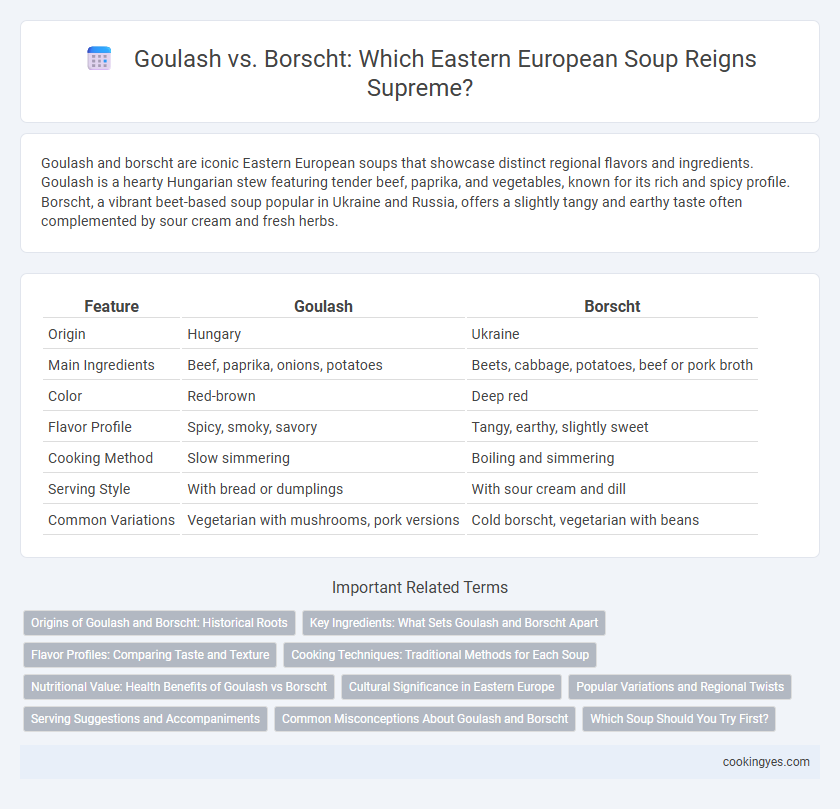Goulash and borscht are iconic Eastern European soups that showcase distinct regional flavors and ingredients. Goulash is a hearty Hungarian stew featuring tender beef, paprika, and vegetables, known for its rich and spicy profile. Borscht, a vibrant beet-based soup popular in Ukraine and Russia, offers a slightly tangy and earthy taste often complemented by sour cream and fresh herbs.
Table of Comparison
| Feature | Goulash | Borscht |
|---|---|---|
| Origin | Hungary | Ukraine |
| Main Ingredients | Beef, paprika, onions, potatoes | Beets, cabbage, potatoes, beef or pork broth |
| Color | Red-brown | Deep red |
| Flavor Profile | Spicy, smoky, savory | Tangy, earthy, slightly sweet |
| Cooking Method | Slow simmering | Boiling and simmering |
| Serving Style | With bread or dumplings | With sour cream and dill |
| Common Variations | Vegetarian with mushrooms, pork versions | Cold borscht, vegetarian with beans |
Origins of Goulash and Borscht: Historical Roots
Goulash originated in Hungary as a hearty shepherd's stew made with paprika, reflecting its roots in the Carpathian Basin during the 9th century. Borscht, with origins tracing back to Ukraine and Russia, is a beet-based soup historically tied to Eastern Slavic agricultural traditions. Both soups embody the cultural and agricultural heritage of Eastern Europe, showcasing distinctive ingredients like paprika in goulash and beets in borscht.
Key Ingredients: What Sets Goulash and Borscht Apart
Goulash features key ingredients such as beef, paprika, onions, and potatoes, creating a rich, hearty stew with a smoky, slightly spicy flavor profile. Borscht is distinguished by its vibrant red beet base, combined with cabbage, carrots, potatoes, and often a dollop of sour cream, giving it a tangy and earthy taste. The primary difference lies in goulash's emphasis on paprika-spiced meat versus borscht's beetroot-centric, vegetable-rich composition.
Flavor Profiles: Comparing Taste and Texture
Goulash features a rich, hearty flavor with smoky paprika and tender beef chunks, offering a thick, stew-like texture. Borscht is characterized by its vibrant, tangy taste from beets and fermented ingredients, combined with a smooth, slightly creamy broth. Both soups showcase distinctive regional spices and ingredients, with goulash delivering a robust, savory experience and borscht providing a refreshing, earthy balance.
Cooking Techniques: Traditional Methods for Each Soup
Goulash is traditionally prepared by slow-cooking beef with onions, paprika, and other spices in a heavy pot, allowing the flavors to meld and the meat to become tender. Borscht relies on boiling and simmering beets, cabbage, and root vegetables in a broth, often finishing with sour cream for added richness. Both soups require patience and precise temperature control to develop their signature depths of flavor and texture.
Nutritional Value: Health Benefits of Goulash vs Borscht
Goulash is rich in protein and iron due to its beef content, supporting muscle growth and blood health, while its paprika provides antioxidants and anti-inflammatory benefits. Borscht, made primarily with beets, offers high levels of fiber, vitamin C, and folate, promoting digestion and cardiovascular health. Both soups deliver essential nutrients but goulash is more protein-dense, whereas borscht excels in vitamins and phytonutrients.
Cultural Significance in Eastern Europe
Goulash, a hearty stew with Hungarian roots, symbolizes the rugged pastoral lifestyle and is central to Hungarian and Slovak heritage, embodying the region's love for paprika and slow-cooked meat. Borscht, with its vibrant beet base, is deeply ingrained in Ukrainian, Russian, and Polish cultures, often associated with festive gatherings and expressing the agrarian traditions through its use of locally grown vegetables. Both soups serve as cultural icons, reflecting the diverse histories, regional ingredients, and social rituals of Eastern Europe.
Popular Variations and Regional Twists
Goulash and Borscht represent iconic Eastern European soups with distinct popular variations rooted in regional traditions. Hungarian Goulash features a rich paprika-infused beef stew often complemented by potatoes and carrots, while Ukrainian Borscht showcases a vibrant beet-based broth enriched with cabbage, potatoes, and a dollop of sour cream. Regional twists include adding smoked meats or beans in Goulash and incorporating apples or kidney beans in Borscht, reflecting local tastes and available ingredients.
Serving Suggestions and Accompaniments
Goulash is traditionally served hot and often accompanied by crusty rye bread or buttered egg noodles, enhancing its rich, paprika-spiced beef broth. Borscht, a beet-based soup, is commonly paired with sour cream and fresh dill, served warm or cold alongside rye bread or garlic rolls to balance its earthy and tangy flavors. Both soups benefit from a dollop of sour cream, which adds creaminess and depth, making them quintessential Eastern European comfort foods.
Common Misconceptions About Goulash and Borscht
Goulash is often mistaken as a soup when it is traditionally a thick stew made with beef, paprika, and onions, while borscht is a beet-based soup known for its vibrant red color and tangy flavor from vinegar or lemon juice. Many believe borscht is always served hot, but it can be enjoyed cold, especially in summer months across Eastern Europe. The misconception that both dishes are interchangeable overlooks their distinct ingredients, cultural significance, and varied regional recipes.
Which Soup Should You Try First?
Goulash offers a rich, paprika-infused broth with tender beef and vegetables, highlighting Hungarian origins, while Borscht features a vibrant beet base with a balance of sour and savory flavors commonly found in Ukrainian cuisine. For a hearty, warming experience, goulash provides robust, smoky depth, whereas borscht delivers a refreshing, tangy profile ideal for those seeking a lighter, colorful soup. Choosing between goulash and borscht depends on your preference for either a spicy, meat-centered stew or a vegetable-rich, slightly tart dish emblematic of Eastern European culinary traditions.
Goulash vs Borscht for Eastern European soups Infographic

 cookingyes.com
cookingyes.com